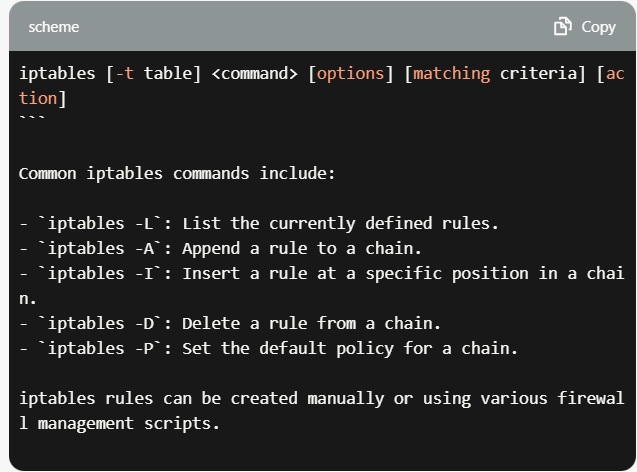Firewall configuration and access control are essential for securing Linux systems and protecting them from unauthorized access and network threats. In Linux, firewall management is typically done using tools like iptables, nftables, and firewalld. Here are some key concepts and techniques for firewall configuration and access control in the Linux operating system:
iptables:iptables is a command-line tool for configuring the netfilter firewall subsystem in the Linux kernel. It allows you to define packet filtering rules based on various criteria such as source/destination IP addresses, port numbers, and protocols. The basic syntax of iptables is as follows:

- nftables:nftables is a newer framework for packet filtering in Linux that replaces iptables. It provides a more modern and efficient approach to firewall configuration. The syntax and usage of nftables differ from iptables, but the basic concept remains the same: defining rules and chains to control network traffic.Some common nftables commands include:
nft list ruleset: List the currently defined rules.nft add rule: Add a rule to a chain.nft insert rule: Insert a rule at a specific position in a chain.nft delete rule: Delete a rule from a chain.nft flush ruleset: Remove all rules from the ruleset.
- firewalld:firewalld is a higher-level firewall management tool introduced in recent versions of Linux distributions. It provides a dynamic and user-friendly interface for configuring firewall rules and managing network zones. firewalld uses nftables as the backend to implement the firewall rules.Some common firewalld commands include:
firewall-cmd --list-all: List the currently defined firewall rules and zones.firewall-cmd --add-service: Allow incoming traffic for a specific service.firewall-cmd --add-port: Allow incoming traffic on a specific port.firewall-cmd --zone: Set the default zone for network interfaces.firewall-cmd --reload: Apply changes to the firewall configuration.
- Access Control:Firewall rules can be used to implement access control policies to allow or deny network traffic based on specific criteria. Some common techniques for access control include:
- Allowing or blocking traffic based on source/destination IP addresses or IP ranges.Allowing or blocking traffic based on source/destination port numbers or port ranges.Defining rules to allow specific protocols (e.g., TCP, UDP) or application-layer protocols (e.g., HTTP, SSH).Implementing stateful packet filtering to allow inbound traffic related to established outbound connections.
- Logging and Monitoring:Firewall logging allows you to capture and analyze network traffic that matches specific rules. By enabling logging, you can monitor the effectiveness of your firewall rules and detect potential security issues or suspicious activities. Firewall logs can be viewed using tools like
dmesg,journalctl, or specific log files in the/var/logdirectory.
Remember to regularly review and update firewall rules based on changing network requirements and security considerations. It’s also recommended to implement additional security measures like intrusion detection systems (IDS), intrusion prevention systems (IPS), and network segmentation to enhance the overall security of your Linux systems.
